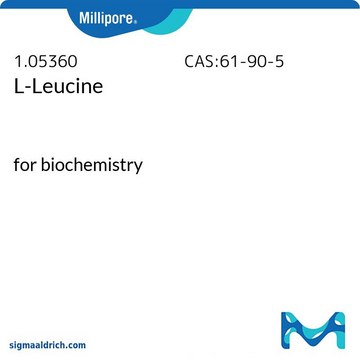L8912
L-Leucine
98.5-101.0%, suitable for cell culture, non-animal source, meets EP, JP, USP testing specifications
Sinónimos:
(S)-Leucine, (S)-2-Amino-4-methylpentanoic acid
About This Item
Productos recomendados
Nombre del producto
L-Leucine, from non-animal source, meets EP, JP, USP testing specifications, suitable for cell culture, 98.5-101.0%
biological source
non-animal source
agency
USP/NF
meets EP testing specifications
meets JP testing specifications
meets USP testing specifications
assay
98.5-101.0%
form
powder
optical activity
[α]20/D 14.9 to 16.0°, c = 4 in 6 M HCl
[α]25/D 14.9 to 17.3 °, c = 4 in 6 M HCl
quality
meets EP, JP, USP testing specifications
technique(s)
cell culture | mammalian: suitable
impurities
endotoxin, tested
color
white
mp
>300 °C (lit.)
solubility
1 M HCl: 50 mg/mL
cation traces
As: ≤1 ppm
Fe: ≤10 ppm
NH4+: <0.02%
heavy metals: ≤10 ppm
application(s)
peptide synthesis
pharmaceutical (small molecule)
functional group
amine
carboxylic acid
storage temp.
room temp
SMILES string
CC(C)C[C@H](N)C(O)=O
InChI
1S/C6H13NO2/c1-4(2)3-5(7)6(8)9/h4-5H,3,7H2,1-2H3,(H,8,9)/t5-/m0/s1
InChI key
ROHFNLRQFUQHCH-YFKPBYRVSA-N
¿Está buscando productos similares? Visita Guía de comparación de productos
General description
Application
- as a hypertrophic agent to monitor its effects on myotubes.
- as a component of PMG media for culturing yeast.
- in myotube protein synthesis analysis in skeletal muscle cells.
- to study its effects on hepatic lipid metabolism.
Biochem/physiol Actions
Other Notes
Application
comparable product
Storage Class
11 - Combustible Solids
wgk_germany
WGK 1
flash_point_f
Not applicable
flash_point_c
Not applicable
ppe
Eyeshields, Gloves, type N95 (US)
Elija entre una de las versiones más recientes:
¿Ya tiene este producto?
Encuentre la documentación para los productos que ha comprado recientemente en la Biblioteca de documentos.
Los clientes también vieron
Chromatograms
application for HPLCNuestro equipo de científicos tiene experiencia en todas las áreas de investigación: Ciencias de la vida, Ciencia de los materiales, Síntesis química, Cromatografía, Analítica y muchas otras.
Póngase en contacto con el Servicio técnico








